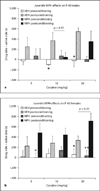Juvenile methylphenidate exposure and factors that influence incentive processing
- PMID: 19372691
- PMCID: PMC5268706
- DOI: 10.1159/000207498
Juvenile methylphenidate exposure and factors that influence incentive processing
Abstract
Methylphenidate (MPH) is one of the few psychotropic agents approved for use in pediatric populations, underscoring the importance of elucidating any long-term consequences following exposure to this agent. Here, we examined the influence of several variables (i.e. age of assessment, age of exposure, sex, route of administration) on the effect of chronic low-dose MPH (2 mg/kg, twice daily) exposure on place conditioning to cocaine. Juvenile exposure to MPH, but not later exposure, resulted in aversions to cocaine-paired environments when assessed in young adult male rats, but not those entering adolescence. Juvenile MPH enhanced place preferences for cocaine-paired environments in female adolescent rats. The route of administration (i.p. injection or oral ingestion) did not produce enduring differential effects on behavior, and D-MPH was confirmed as the active enantiomer. These observations add to the growing literature on the enduring effects of MPH exposure, and highlight the need for more research in females.
2009 S. Karger AG, Basel.
Figures






References
-
- Wagner FA, Anthony JC. From first drug use to drug dependence; developmental periods of risk for dependence upon marijuana, cocaine, and alcohol. Neuropsychopharmacology. 2002;26:479–488. - PubMed
-
- Johnston LD, et al. Monitoring the future. National results on adolescent drug use. Overview of key findings. 2007
-
- Rapoport JL, Buchsbaum MS, Zahn TP, Weingartner H, Ludlow C, Mikkelsen EJ. Dextroamphetamine: cognitive and behavioral effects in normal prepubertal boys. Science. 1978;199:560–563. - PubMed
-
- Wilens TE, Faraone SV, Biederman J, Gunawardene S. Does stimulant therapy of attention-deficit/hyperactivity disorder beget later substance abuse?. A meta-analytic review of the literature. Pediatrics. 2003;111:179–185. - PubMed
-
- Dafny N, Yang PB. The role of age, genotype, sex, and route of acute and chronic administration of methylphenidate: a review of its locomotor effects. Brain Res Bull. 2006;68:393–405. - PubMed
Publication types
MeSH terms
Substances
Grants and funding
LinkOut - more resources
Full Text Sources

